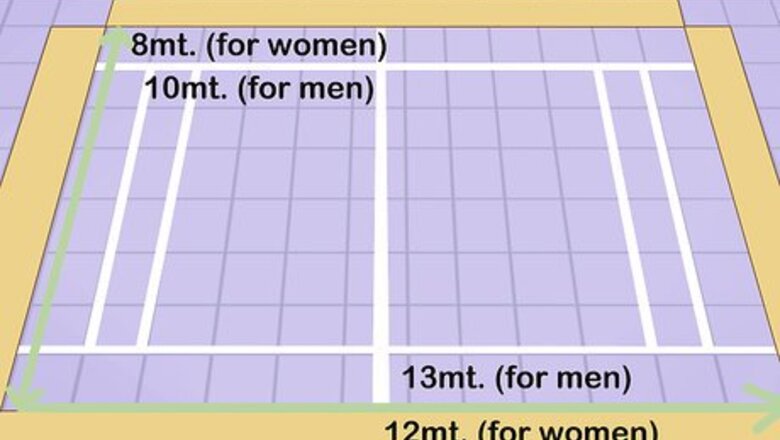
views
X
Research source
Setting Up
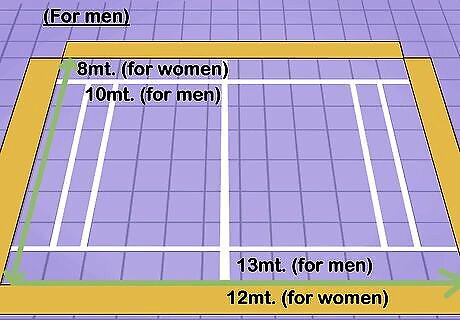
Play in a flat, rectangular arena 13 meters (42.7 ft) wide x 10 meters (32.8 ft) long. These are the official measurements for professional men's Kabaddi — if you're just playing casually with friends, your play area doesn't need to be exactly this size. However, it should be flat, open, and roughly rectangular. For women's Kabaddi, the court size is slightly smaller — 12 meters (39.4 ft) wide x 8 meters (26.2 ft) long.
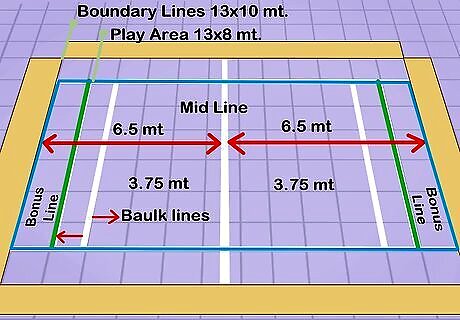
Use lines and markings to divide the court appropriately. The following are the official court markings as specified for professional Kabaddi; again, if you're playing casually with friends, your markings don't need to be exact. Boundary lines: The lines at the edge of the 13 meter x 10 meter court. Play area lines: These lines mark a 13 meter x 8 meter rectangular area inside the court — one meter of space separates each side from the 10 meter boundary lines above. Mid line: This line divides the court into two 6.5 meters (21.3 ft) x 8 meter halves. Each team's "territory" is the play area on its side of the mid line. Baulk lines: These lines run parallel to the mid line and are 3.75 meters (12.3 ft) from it on either side. Bonus lines: These lines run parallel to the baulk lines and are 1 meter (3.3 ft) from them on the side opposite the mid line.
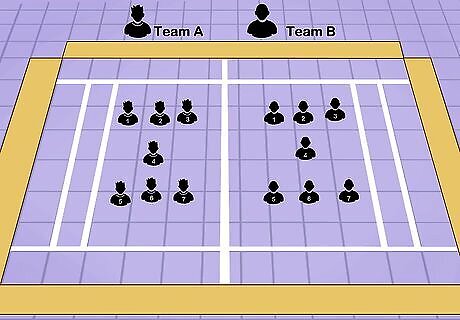
Divide into two teams of seven players each. Traditionally, four players from each team take each side of the field, leaving each team with three players held in reserve. However, some variations of Kabaddi call for all seven players to take the field at once.
Understanding the Basics

Flip a coin to decide which team will go first. Any sort of random method for determining which team goes first is fair game — you can also try rolling for the highest dice roll, guessing a number that a non-biased referee is thinking of, etc.

If your team goes first, send a "raider" across the mid line. In Kabaddi, teams take turns sending players (called "raiders") across the mid line to the other team's side of the court. The raider tries to tag members of the other team and run back to his side within 30 seconds — each player he touches equals one point for his team if he makes it back safely. However, the raider must start repeatedly yelling "Kabaddi" before he crosses the mid line and cannot stop repeating this word until he crosses back over to his team's side. If he stops yelling or takes a breath on the opponent's side of the court, even momentarily, he must return to his own side of the court, scoring no points. In this case, one point is awarded to the defending team for a successful play. Each member of a team must raid in sequence — if a team member raids out of order, the opposing team gets one point.
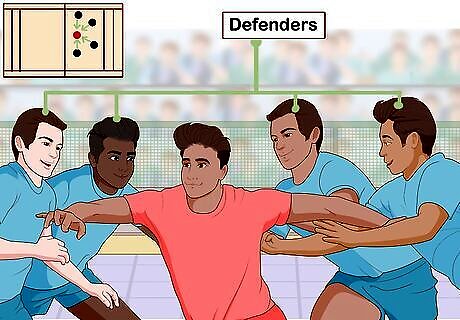
If your team doesn't go first, defend! If your team is being raided, you and the other three players in play are "anti-raiders" or "stoppers." Your goal is to keep the raider from tagging you and crossing back over the midline. You can do this either by running away from him until he runs out of breath or physically restraining him by tackling or grabbing him. Note that a raider may not be grabbed or held by his clothes, hair, or any part of his body other than his limbs and torso.

Take turns alternating between raiding and defending. The two teams alternate between raiding and defending for two halves of twenty minutes each (with a five minute break between halves.) After halftime, the two teams switch sides of the court. The team with the most points at the end of the game wins!

Send players out when they are tagged, captured, or break a rule. In Kabaddi, players can be temporarily sent "out" of play for a variety of reasons. If this happens, they may not be replaced by players in reserve — substitutions are only made for players who are not out. Below are a list of circumstances in which a player may be sent out. If the raider tags any defending players and makes it back to his side, the players he tagged are out. If a raider is captured and cannot pass back over the midline before he runs out of breath, he is out. If any player (raiding or defending) steps outside the boundary lines, he is out (unless he was deliberately pulled or shoved, in which case, the offending player is out.) If a team has three unproductive raids in a row, the third raider is out. An unproductive raid occurs when a raider cannot score any points (or loses points) during a raid. However, if a raider can cross the baulk line and return to his side of the court, the raid counts as a successful one even if he doesn't tag anyone. If a defending team member enters the raider's side of the court before his team is officially given the chance to raid, he is out.

"Revive" players by getting an opponent out. Whenever your team gets a member of the opponent team out, you have a chance to bring back (or "revive") someone on your team who has previously been ruled out. This is true for both raiding and defending teams. Players are revived in the order they were gotten out — bringing back players out of order results in a point for the other team.
Using Advanced Scoring Rules

Score a "Lona" by getting the entire other team out. If you can get the entire other team out at once for any combination of reasons and none of their players are eligible for revival, your team scores a "Lona" (two extra points for that play.) When this happens, the entire opposing team is revived.
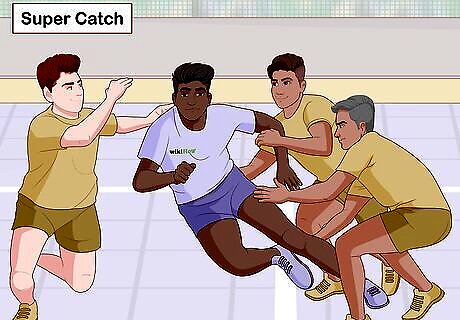
Score a "super tackle" by capturing the opponent with three or fewer defenders. If your team is defending with less than three players and you still manage to prevent the raider from getting back to his side of the court, you score an additional "super tackle" point. This point is on top of the point you get for getting the raider out, so you get two points in total for the play.

Score points when your opponents break the game's rules. Most penalties in Kabaddi result in one point being awarded to the opposing team. Below is a list of offenses that can earn the opposing team points. If a raider says anything besides the pre-approved "Kabbadi" chant while he is raiding, the raid is over and the defending team gets a point plus the chance to raid (but the raider is not out.) If the raider starts his chant late (in other words, after he crosses the mid line), the raid is over and the defending team gets a point plus the chance to raid (but, again, the raider is not out.) If a raider goes out of order, the defending team gets a point and the raid is over. If more than one raider enter the opponent's court at once, the raid is over and the defending team gets a point. If any defenders enter the raider's side of the court before it is their turn to raid, each defender that does so earns a point for the other team. If, after a Lona, the wiped-out team doesn't return its revived players back to the field within ten seconds, the opposing team earns one point. If the raider's teammates attempt to help him by calling out warnings or advice, the defending team gets a point. If players deliberately get out in order to force a Lona and revive their team members, the opposing team scores an extra point for each offending player that was on the field in addition to the two Lona points.




















Comments
0 comment